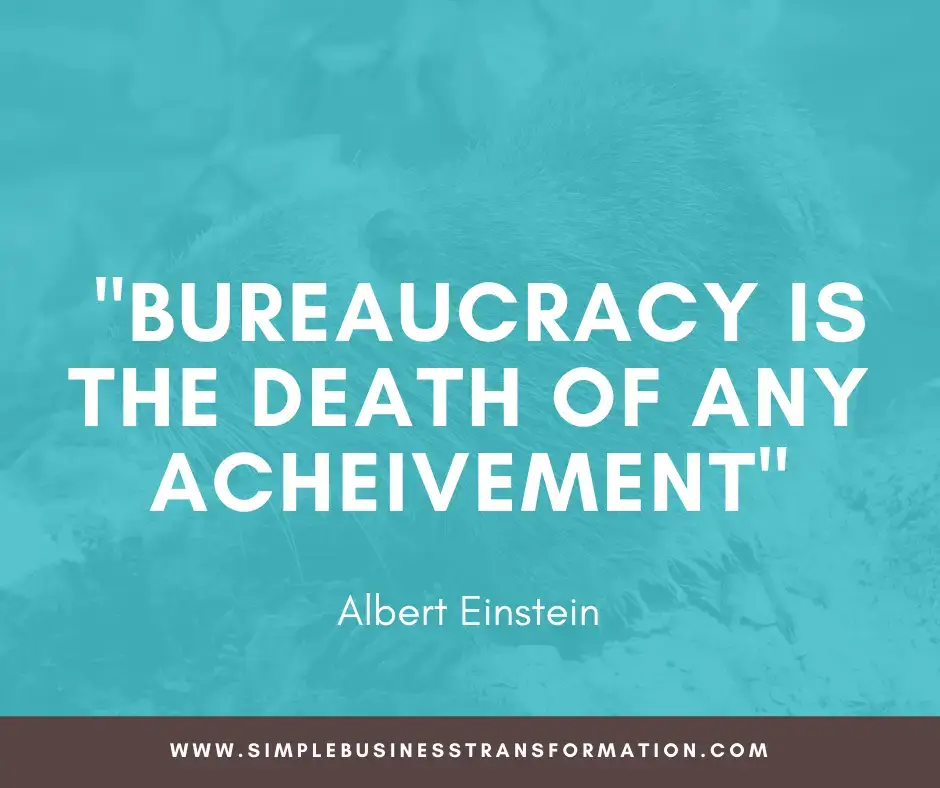Introduction
Bureaucracy in a business context refers to the administrative system governing any large institution, characterised by
- standardised procedures
- formal division of responsibilities
- hierarchy, and
- impersonal relationships.
It typically involves a complex framework of rules and regulations intended to manage organisational activities and ensure consistency and control.
While bureaucracy can help maintain order and accountability, it often becomes synonymous with excessive red tape, leading to inefficiencies.
Signs of Bureaucratic Inefficiency
In my experience, bureaucracy takes 2 forms
1. Low Level Value Management Processes
These are processes that have evolved over time. They add no value and are often there because That’s how we’ve always done it”
Here are some examples
- 8 signatures required to sign off a purchase order which slows down the purchase and sits in people’s inboxes waiting for action
- Excessive Paperwork: One of the most evident signs of bureaucratic inefficiency is the proliferation of paperwork.
This includes forms, reports, and documentation that require extensive time and effort to complete and process, often resulting in delayed decision-making and action.
- Slow Decision-Making Processes: Bureaucratic organisations tend to have multiple layers of approval and review, which slow down decision-making.
This can hinder the organisation’s ability to respond quickly to market changes or internal issues, leading to missed opportunities and frustration among employees.
- Internal process – too much time spent on internal issues such a levelling of people’s performance scores, preparing endless re iterations of budget submissions
- Rigid Procedures and Policies: Bureaucracies are known for their strict adherence to established procedures and policies, which can limit flexibility and adaptability.
Employees may find it challenging to implement new ideas or processes due to the rigid framework.
You get the picture? These are the easiest things to fix.
2. Organisational Structure
This is so much more complicated because it requires a bigger culture change. Let’s look at some examples.
- Stove piped organisations: where communication and collaboration become stymied.
- Spans and layers: in an organisation where businesses are often top heavy in management roles and there are too many layers between CEO and team member.
- Hierarchical Bottlenecks: In a heavily bureaucratic structure, decisions often need to pass through several levels of hierarchy. This not only delays actions but also stifles innovation, as ideas and initiatives get lost or watered down as they move up the chain of command.
- Fat in the organisation: with too many back office or administration people such as support teams, HR, Finance etc. Often managers “protect” their teams by hanging on to them as they are reluctant to lose staff.
- Lack of autonomy: people not able or empowered to make decisions that benefit the customer and the business.
- Risk aversion: Employes who are scared to take risks, usually for career reasons.
- Politics: infighting, battling for power and influence
- Lack of Empowerment: Bureaucratic organisations often centralise authority, leaving employees with little autonomy or decision-making power.
This can result in low morale, decreased motivation, and a lack of initiative among staff.
Impact on Costs
Wasted Time: The time spent navigating bureaucratic procedures and waiting for approvals is a significant cost.
Employees could use this time for more productive activities, such as developing new ideas, improving customer service, or optimising operations.
Resource Inefficiency: Bureaucracy can lead to the inefficient use of resources.
For instance, excessive paperwork and redundant processes consume office supplies, space, and technology resources that could be better allocated elsewhere.
Opportunity Costs: Slow decision-making and inflexibility mean that businesses may miss out on opportunities that require quick action.
This can include potential partnerships, market expansion, or adapting to customer needs.
Higher Operational Costs: Maintaining a large administrative staff to manage bureaucratic processes can be costly.
These positions, while necessary to some extent, can balloon out of proportion in a highly bureaucratic environment, adding to operational expenses without directly contributing to value creation.
Reduced Innovation: A bureaucratic culture stifles innovation, which is costly in the long run.
The inability to swiftly implement new ideas or adapt to changing circumstances can hinder a company’s growth and competitiveness.
By understanding the nature of bureaucracy and recognising the signs of bureaucratic inefficiency, businesses can take steps to streamline their processes, reduce waste, and enhance overall productivity.
Addressing these issues is crucial for improving operational efficiency, reducing costs, and fostering a more dynamic and responsive organisational culture.
Why does it happen?
Bureaucracy Created in the Belief It Protects the Company or Makes it More Efficient
Often bureaucracy comes about when people in the business genuinely want to increase efficiency and reduce waste within the business.
For example an excessively lengthy contract can end up being written if the person that wrote it didn’t want the company to be liable for anything and over engineered it to protect the company.
It’s the same for processes, procedures and policies which are put in place for seemingly logical reasons, but are not balanced with the potential operational difficulty and increased cost that they may incur.
Created as Companies Grow
As a start up, or any other business grows, new functions are added to deal with new scenarios.
The ratio of managers to team members goes up. Back office, offline and centralised functions are developed and grown.
The centralised functions provide internal services to market facing operational units which dictate policy and can have customer unfriendly processes.
How many times have you found that dealing with Finance, HR or IT is a barrier to getting things done?
Created by Employees to Protect Their Interests
As a transformation expert I tell employers and clients that I should save them more than I cost. And that, if I do my job right, I should do myself out of a job.
But how many of your direct reports come to you and say ”I reckon I could reduce the size of my team/organisation by 40%?”
It just wouldn’t happen would it? If anything, they will build their role and organisation and request more people not less, and this is because Managers see a large team or organisation as a representation of the value they have within the company.
Would they still get a seat at the table with a smaller organisation or would you merge it with another team and lose them? It’s a risk and one they may not be willing to take.
What Are the Risks and Consequences of Bureaucracy on the Business?
Complexity Increases and Costs Go Up
As the company grows so does the need for more meetings, more reports, more performance management, all to ensure that the operation runs smoothly.
People Become Disempowered
Frontline employees often struggle to make decisions that benefit the business due to friction within the process.
Significant time is spent navigating company policies and overcoming barriers to getting things done.
This disempowerment leads to employee turnover, driving up costs through wasted training and increased recruitment efforts.
A recent example involved customer care agents who were unable to refund customers £1.50 because the company feared potential abuse, with agents possibly refunding friends and family.
The existing process required one agent to raise the refund request, another to process it, and a third to verify it.
This cumbersome procedure resulted in customer dissatisfaction, as customers had to wait days for authorisation of their refunds.
This situation exemplifies bureaucracy at its worst—slowing company processes, increasing time and costs, disempowering employees, and dissatisfying customers.
A simple solution is to monitor the number and value of refunds agents issue, allowing the process to be tracked and anomalies investigated.
Empowering agents to resolve customer issues immediately can transform a process that previously took multiple agents hours or even days into a task completed in minutes.
This change boosts efficiency, reduces costs, and improves both employee and customer satisfaction.
You Can’t Assess an Individual’s Actual Contribution
As organisations grow with more layers and specialised functions, accurately assessing individual contributions to the bottom line becomes increasingly challenging.
When the roles and impacts of individuals, teams, or functions are not clearly defined, it is difficult to demonstrate their value in performance management.
Consider these questions:
- How does their work impact the bottom line?
- What would happen if they stopped doing their job tomorrow?
- Would you notice?
Addressing these uncertainties is crucial for effective performance evaluation and demonstrating the value of each role.
It Takes Longer and Longer to Make a Decision
The decision-making process lacks agility. Without empowering individuals, more meetings are necessary, creating bottlenecks when higher-level decision makers are unavailable. Additionally, varying agendas can lead to inconsistent and conflicting decisions.
By equipping employees with the right skills and delegating decision-making to lower levels, you can reduce delays and streamline the process, eliminating much of the drag in your current decision-making procedures.
Assessing Bureaucratic Challenges in Your Organisation
Understanding and addressing bureaucratic inefficiencies is crucial for optimising performance and reducing costs.
This section outlines how to conduct a bureaucracy audit and quantify its financial impact on your organisation.
Conduct a Bureaucracy Audit via Employee Feedback
Understanding the level of bureaucracy in your organisation is the first step. And this can be done in a number of ways.
Anonymous Surveys: Distribute anonymous surveys to gather candid feedback from employees about bureaucratic obstacles they face.
Questions should focus on their daily tasks, decision-making processes, and suggestions for improvement.
Focus Groups: Conduct focus group discussions with representatives from different departments to gain deeper insights into specific bureaucratic issues and gather qualitative data.
Open Forums: Host open forums or town hall meetings where employees can voice their concerns and suggestions directly to management.
This promotes transparency and encourages a culture of openness.
Analyse Workflows and Decision-Making Pathways
Process Mapping: Create detailed process maps of key workflows to visualise the steps involved, identify bottlenecks, and understand the flow of information and tasks.
Workflow Analysis: Examine how tasks move through the organisation, noting any delays, redundancies, or unnecessary steps. Identify where decisions are made and how long they take.
Decision Log: Maintain a decision log to track who makes decisions, how long it takes, and any delays encountered. This helps pinpoint where decision-making is slowed by bureaucratic hurdles.
Identify Redundant Processes and Unnecessary Approvals
Redundancy Check: Review all processes to identify redundant tasks that add no value. Examples include multiple approvals for routine tasks or duplicative data entry.
Approval Streamlining: Assess the necessity of each approval step. Determine which approvals are truly necessary and which can be eliminated or automated to speed up processes.
Lean Review: Apply Lean principles to evaluate processes for waste, such as overproduction, waiting, excess motion, and over-processing. Identify opportunities to streamline and simplify workflows.
Quantifying Bureaucratic Costs
Time Tracking and Productivity Analysis
Time Audits: Conduct time audits to measure how much time employees spend on bureaucratic tasks, such as filling out forms, waiting for approvals, and attending unnecessary meetings.
Use time tracking tools to gather accurate data.
Productivity Metrics: Analyse productivity metrics to compare the time spent on bureaucratic tasks versus value-adding activities.
Metrics might include time to complete a task, number of tasks completed, and output quality.
Benchmarking: Compare your organisation’s time and productivity metrics with industry standards or best practices to identify areas for improvement.
Cost of Delays and Missed Opportunities
Delay Cost Calculation: Calculate the financial impact of delays caused by bureaucratic inefficiencies.
This includes the cost of extended project timelines, delayed product launches, and missed deadlines.
Opportunity Cost Analysis: Assess the opportunity costs associated with slow decision-making and inflexible processes.
Consider lost revenue from potential deals, partnerships, or market opportunities that were missed due to bureaucratic delays.
Resource Allocation: Evaluate the cost of resources tied up in bureaucratic processes, such as salaries of employees involved in redundant tasks, office supplies, and technological resources.
Calculate the potential savings from reallocating these resources to more productive uses.
By conducting a thorough bureaucracy audit and quantifying the costs of bureaucratic inefficiencies, organisations can identify specific areas that need improvement.
This structured approach provides a clear understanding of the extent of bureaucratic challenges and offers a solid foundation for implementing targeted strategies to streamline processes, reduce waste, and enhance overall efficiency.
Strategies to Beat Bureaucracy
Reducing bureaucratic inefficiencies requires a strategic approach that streamlines processes, empowers employees, leverages technology, adopts Lean principles, and enhances communication.
Here are key strategies to achieve these goals:
Streamlining Processes by Simplifying Approval Chains
Reduce Layers of Approval: Limit the number of required approvals to only those that are absolutely necessary. This reduces delays and accelerates decision-making.
Empower Frontline Managers: Allow frontline managers to make more decisions without needing upper management approval, speeding up routine processes.
Implement Decision-Making Frameworks
RACI Matrix: Use the RACI (Responsible, Accountable, Consulted, Informed) matrix to clarify roles and responsibilities in decision-making processes.
This framework ensures that everyone knows who is responsible for each task, who must approve decisions, who needs to be consulted, and who should be informed.
Decision Trees: Develop decision trees to guide employees through complex decision-making processes.
This visual tool helps streamline choices and ensures consistency in handling various scenarios.
Empowering Employees by Delegating Authority and Promoting Autonomy
Decentralise Decision-Making: Shift decision-making authority closer to the point of action.
This empowers employees to make decisions without always needing to escalate them, reducing bottlenecks.
Encourage Initiative: Create an environment where employees feel confident to take initiative and make decisions within their scope of work.
Encourage a Culture of Trust and Accountability
Trust-Based Leadership: Foster a culture of trust by showing confidence in employees’ abilities and decisions.
Trust motivates employees to take ownership of their work and be more innovative.
Accountability Systems: Implement systems that hold employees accountable for their actions and decisions.
Clear expectations and regular performance reviews can help maintain high standards and responsibility.
Leverage Technology and Utilise Workflow Automation Tools
Automate Routine Tasks: Use workflow automation tools to handle repetitive and routine tasks. Automation can reduce errors, save time, and free up employees for more valuable work.
Digital Approvals: Implement digital approval systems that allow for faster, paperless approvals. These systems can track and record all approvals, ensuring transparency and efficiency.
Adopt Project Management Software
Streamlined Communication: Use project management software to centralise communication, task assignments, and progress tracking.
Tools like Asana, Trello, or Monday.com can help teams stay organised and aligned.
Task Tracking: Implement task tracking features to monitor progress and deadlines. This ensures accountability and helps identify bottlenecks in real-time.
Adopt Lean Principles and Introduce Lean Methodologies to Eliminate Waste
Value Stream Mapping: Use value stream mapping to visualise and analyse the flow of materials and information required to bring a product or service to the customer. Identify and eliminate non-value-adding steps.
5S Methodology: Implement the 5S methodology (Sort, Set in order, Shine, Standardise, Sustain) to organise the workplace, reduce waste, and improve efficiency.
Conduct Regular Kaizen Events for Continuous Improvement
Kaizen Workshops: Hold regular Kaizen workshops to engage employees in identifying and implementing incremental improvements. These events foster a culture of continuous improvement and innovation.
Continuous Feedback Loop: Establish a feedback loop where employees can regularly suggest improvements and report on the impact of changes made.
Enhance Communication by Promoting Transparent and Open Communication Channels
Open Door Policies: Encourage open door policies where employees can freely discuss concerns and ideas with management.
This transparency helps build trust and ensures that issues are addressed promptly.
Regular Updates: Implement regular updates, such as weekly briefings or newsletters, to keep everyone informed about ongoing projects and changes.
Reduce Unnecessary Meetings and Opt for More Efficient Communication Methods
Effective Meeting Practices: Limit the number of meetings and ensure they are necessary, focused, and productive. Use agendas to keep meetings on track and allocate specific times for each topic.
Collaborative Platforms: Utilise collaborative platforms like Slack, Microsoft Teams, or Google Workspace for quick, efficient communication.
These tools enable real-time collaboration and reduce the need for lengthy meetings.
By applying these strategies, organisations can significantly reduce bureaucratic inefficiencies, enhance productivity, and foster a more dynamic and responsive work environment.
Implementing Change
Successfully implementing change to beat bureaucracy requires a structured approach, effective change management, comprehensive training, and continuous monitoring and feedback.
Here’s how to achieve this:
Structured Approach to Managing Change
Using a structured change management model, such as Kotter’s 8-Step Change Model, can guide the organisation through the transition:
Create a Sense of Urgency: Highlight the importance of reducing bureaucracy and the benefits it will bring to the organisation.
Use data and examples to illustrate the current inefficiencies and potential savings.
Build a Guiding Coalition: Form a group of influential stakeholders and leaders who are committed to driving the change. This coalition will lead and support the change effort.
Develop a Vision and Strategy: Clearly articulate the vision for a streamlined, efficient organisation and develop a strategy to achieve it. This should include specific goals, timelines, and metrics.
Communicate the Vision: Share the vision and strategy with the entire organisation through multiple channels. Ensure that the message is clear, consistent, and compelling.
Remove Obstacles: Identify and address barriers to change. This may involve revising policies, reallocating resources, or addressing resistance from certain individuals or groups.
Generate Short-Term Wins: Achieve and celebrate small, early successes to build momentum and demonstrate the benefits of the change. This helps to maintain motivation and commitment.
Consolidate Gains and Produce More Change: Use the credibility gained from short-term wins to drive deeper changes. Keep looking for improvements and ensure that the change becomes embedded in the organisation.
Anchor New Approaches in the Culture: Ensure that the new ways of working become part of the organisational culture. Reinforce the changes through policies, practices, and the behaviour of leaders.
Engage Stakeholders and Build Consensus
Inclusive Planning: Involve key stakeholders in the planning process to ensure their perspectives and concerns are considered. This can help build buy-in and reduce resistance.
Transparent Communication: Maintain open lines of communication with all stakeholders throughout the change process. Regular updates, Q&A sessions, and feedback mechanisms can help keep everyone informed and engaged.
Consensus Building: Use workshops, meetings, and collaborative platforms to discuss the change initiatives and build consensus. Address concerns and incorporate stakeholder feedback to refine the approach.
Training and Development
Provide Training for Employees on New Tools and Streamlined Processes
Comprehensive Training Programs: Develop training programs that cover the new tools, processes, and methodologies being introduced. Ensure that training is hands-on and practical.
Tailored Training: Customise training sessions to address the specific needs of different departments and roles within the organisation. Provide role-specific training to ensure relevance.
Offer Continuous Development Opportunities to Foster a Culture of Efficiency
Ongoing Education: Provide opportunities for continuous learning and development. This can include workshops, webinars, online courses, and certifications.
Mentorship and Coaching: Establish mentorship and coaching programs to support employees as they adapt to new ways of working. Experienced mentors can provide guidance and encouragement.
Resource Libraries: Create a resource library with training materials, guides, and best practices that employees can access anytime.
Monitoring and Feedback
Set Up Mechanisms for Ongoing Monitoring and Feedback
Performance Metrics: Define key performance indicators (KPIs) to monitor the progress of the change initiatives. Metrics might include time saved, cost reductions, process efficiency, and employee satisfaction.
Regular Reviews: Conduct regular reviews to assess the effectiveness of the changes. Use dashboards and reports to track performance against the defined KPIs.
Adjust Strategies Based on Feedback and Performance Data
Feedback Loops: Establish feedback loops where employees can provide input on the new processes and tools. This can include surveys, suggestion boxes, and regular check-in meetings.
Continuous Improvement: Use the feedback and performance data to identify areas for further improvement.
Make adjustments to the strategies and processes as needed to ensure they remain effective and aligned with organisational goals.
Agile Approach: Adopt an agile approach to change management, where continuous iteration and refinement are part of the process.
Be open to pivoting and adapting strategies based on real-time feedback and results.
By implementing these structured change management strategies, providing comprehensive training and development, and maintaining ongoing monitoring and feedback, organisations can effectively reduce bureaucracy and create a more efficient and productive work environment.
Case Studies and Success Stories
Understanding how other businesses have successfully reduced bureaucracy can provide valuable insights and inspiration.
Here, we highlight several real-world examples of organisations that streamlined their operations, saved money, and enhanced efficiency.
We also extract key lessons learned and best practices from their experiences.
Real-World Examples
Toyota
Initiative: Lean Manufacturing
Overview: Toyota is renowned for its Toyota Production System (TPS), which emphasises Lean manufacturing principles to eliminate waste and improve efficiency.
Results: By adopting Lean methodologies, Toyota significantly reduced production times and costs while improving product quality and customer satisfaction.
General Electric (GE)
Initiative: Six Sigma Implementation
Overview: GE implemented Six Sigma to reduce defects and improve processes across its diverse operations.
Results: Six Sigma projects at GE led to substantial cost savings, improved product quality, and increased customer satisfaction. The initiative also fostered a culture of continuous improvement within the company.
Southwest Airlines
Initiative: Simplified Operations
Overview: Southwest Airlines streamlined its operations by reducing unnecessary processes and focusing on customer-centric improvements.
Results: This approach allowed Southwest to maintain low operational costs, offer competitive prices, and achieve high customer satisfaction and loyalty.
The airline’s efficient boarding process and quick turnaround times became industry benchmarks.
3M
Initiative: 15% Rule and Six Sigma
Overview: 3M introduced the “15% rule,” allowing employees to spend 15% of their time on projects of their choosing, fostering innovation.
Additionally, 3M adopted Six Sigma to enhance operational efficiency.
Results: The combination of employee empowerment and process improvement led to numerous innovations, cost savings, and enhanced operational efficiency.
The 15% rule was instrumental in the creation of iconic products like Post-it Notes.
Lessons Learned
Empower Employees
Key Takeaway: Empowering employees to take ownership of their work and contribute ideas for improvement is crucial. This fosters a culture of innovation and engagement.
Example: 3M’s 15% rule demonstrated the value of giving employees the freedom to explore new ideas, leading to breakthrough innovations.
Adopt Proven Methodologies
Key Takeaway: Implementing established process improvement methodologies like Lean and Six Sigma can lead to significant efficiency gains and cost reductions.
Example: GE’s use of Six Sigma not only improved product quality but also ingrained a culture of continuous improvement throughout the organisation.
Simplify Processes
Key Takeaway: Simplifying and standardising processes can reduce complexity, save time, and lower costs.
Example: Southwest Airlines’ streamlined operations enabled it to maintain low costs and high efficiency, setting it apart from competitors.
Foster a Culture of Continuous Improvement
Key Takeaway: A culture that encourages continuous improvement and innovation is essential for long-term success.
Example: Toyota’s commitment to Lean manufacturing principles ensured that continuous improvement was a core part of its operations, driving efficiency and quality.
Utilise Data and Metrics
Key Takeaway: Regularly tracking performance metrics and using data-driven decision-making can help identify areas for improvement and measure the impact of changes.
Example: GE’s rigorous use of Six Sigma metrics enabled precise tracking of process improvements and their financial impact.
Customer-Centric Focus
Key Takeaway: Keeping the customer at the center of process improvement efforts ensures that changes add value and enhance customer satisfaction.
Example: Southwest Airlines’ focus on efficient, customer-friendly processes contributed to its high levels of customer loyalty and operational success.
By examining these case studies and understanding the lessons learned, organisations can adopt best practices to reduce bureaucracy, save money, and foster a more efficient and innovative work environment.
Conclusion
Reducing bureaucracy and its associated inefficiencies can significantly enhance an organisation’s performance, productivity, and cost savings.
In this blog, we’ve explored various aspects of tackling bureaucratic challenges and provided practical strategies to streamline operations and foster a culture of efficiency.
Key Points
Understanding Bureaucracy in Business: We defined bureaucracy, identified signs of inefficiency, and discussed its impact on costs, such as wasted time, resources, and missed opportunities.
Assessing Bureaucratic Challenges: We outlined steps for conducting a bureaucracy audit, including surveying employees, analysing workflows, and identifying redundant processes.
Methods for quantifying bureaucratic costs through time tracking and productivity analysis were also discussed.
Strategies to Beat Bureaucracy: We presented strategies such as streamlining processes, empowering employees, leveraging technology, adopting Lean principles, and enhancing communication.
Implementing Change: We emphasised the importance of structured change management, training and development, and continuous monitoring and feedback.
Case Studies and Success Stories: Real-world examples demonstrated how companies like Toyota, GE, Southwest Airlines, and 3M successfully reduced bureaucracy and reaped significant benefits.
Final Thoughts
Taking the first steps toward reducing bureaucracy can seem daunting, but the benefits are substantial.
Streamlined processes lead to faster decision-making, improved employee morale, enhanced customer satisfaction, and significant cost savings.
Empowering your team, leveraging modern technology, and fostering a culture of continuous improvement are crucial elements for success.
Remember, even small changes can lead to significant improvements over time.
Nest Steps
We encourage you to begin by conducting a bureaucracy audit within your organisation.
Identify the key areas where bureaucratic inefficiencies exist and quantify their impact.
Use the strategies outlined in this blog to develop a targeted plan for reducing bureaucracy and streamlining your operations.
Engage your employees, utilise available technology, and adopt proven methodologies to drive meaningful change.
By taking these steps, you can start saving money, improving efficiency, and creating a more dynamic and responsive organisation.
Embrace the journey of continuous improvement and watch your business thrive as you beat bureaucracy and unlock its full potential.





